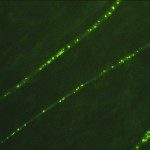Link to Pubmed [PMID] – 15765808
J. Neurovirol. 2004 Dec;10(6):372-82
Following its injection into the hindlimbs of mice, CVS, a highly pathogenic strain of rabies virus, invades the spinal cord and brain resulting in the death of the animal. In contrast, central nervous system (CNS) invasion by PV, a strain of attenuated pathogenicity, is restricted to the spinal cord and mice infected with this virus survive. Lymphocytes display transient migration into the infected CNS in fatal rabies and sustained migration in nonfatal rabies. The transient migration of T cells in fatal rabies is associated with an increase in T-cell apoptosis. We found that the early production of Fas ligand (FasL) mRNAs was up-regulated only in fatal rabies. FasL is produced by several neuronal cells and mainly in infected neurons. In mice lacking FasL (gld), infection with the neuroinvasive rabies virus strain was less severe, and the number of CD3 T cells undergoing apoptosis was smaller than that in normal mice. These data provide strong evidence that fatal rabies virus infection involves the early triggering of FasL production leading to the destruction of migratory T cells by the Fas/FasL apoptosis pathway. This mechanism could be in part responsible for the fact that T cells cannot control neuroinvasive rabies infection. Thus, rabies virus seems to use an immunosubversive strategy that takes advantage of the immune privilege status of the CNS.

